Cancer – complementary treatment
Cancer is increasingly becoming one of the most threatening widespread diseases. Yet living with cancer is arduous and the risk of death considerable.
The conventional medical therapies are often associated with severe side effects, which can often be alleviated and supplemented with naturopathic treatments. The optimal cancer therapy is always based on numerous complementary pillars such as a natural diet rich in vital substances, exercise, naturopathy, strengthening measures for body and soul. Vital mushrooms are also an important pillar of complementary medicine and can support the conventional treatment by a variety of useful mechanisms and ingredients of the mushrooms.
Let us explain to you how vital mushrooms can support the immune system during and after chemotherapy or radiation and how it can reduce unpleasant side effects.
Cancer – a disease with many faces
Who gets cancer?
Theoretically, every human being and every mammal can get cancer.  Nowadays, cancer tumours are one of the most serious problems of our civilization. After cardiovascular diseases, cancer is the second most common cause of death in Western society.
Nowadays, cancer tumours are one of the most serious problems of our civilization. After cardiovascular diseases, cancer is the second most common cause of death in Western society.
The incidence rate is highest among people over 60 years of age. About three quarters of all cancers fall into this age group. However, younger people can also develop tumours. With children, cancer is mainly diagnosed in the brain, spinal cord, lymph nodes and blood (leukaemia).
What types of cancer exist?
Cancer develops from a single cell. In principle, this cell can be located anywhere in the body. However, cancer needs many cell divisions to grow. Therefore, it grows preferentially from cells that divide frequently, such as epithelial cells, which are found in the skin and mucous membranes. There are tumours in stomach, liver, kidneys, thyroid gland, urinary bladder, oral pharynx, oesophagus, pancreas, ovaries, testicles and some other places in the body. The most common types of cancer are:
– Breast cancer – predominantly women are affected
– colon cancer
– prostate cancer
– lung cancer
Which type of cancer is curable?
When it comes to curing cancer, we can only ever talk about probabilities. Some kinds of cancer are particularly difficult to treat because of their characteristics. Some tumours develop the ability to “attract” blood vessels. In this way, they overcome encapsulation and build up their own supply of nutrients.
The formation of metastases is particularly serious. When a cancer manages to invade surrounding tissue or to cause cancer cells to migrate through the body via the lymphatic system or bloodstream, experts speak of “malignant” tumours. If metastasis occurs in particularly sensitive locations such as the lungs, brain, bones or liver, the cancer is virtually unstoppable. In fact, 90% of deaths in cancer patients are not due to the original tumour, but because of its metastases.
Unlike malignant tumours, which carry a high risk of recurrence even with successful treatment, benign tumours can be easily removed surgically. Their growth is clearly circumscribed and they do not invade foreign tissue. One speaks of “cancer” only in the case of malignant tumours.
Causes and treatment
How does cancer develop?
In our body, cells are constantly forming and dying. Cancer has its beginning precisely in this dynamic process: where it occurs, the balance between the formation of new cells and the death of cells is mixed up. To regulate the cell division process, 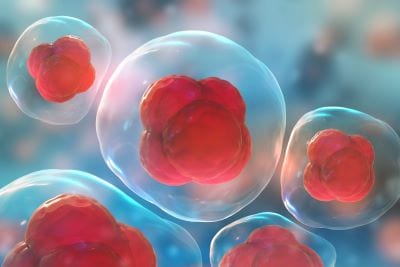 there are oncogenes that stimulate cell growth and tumour suppressor genes that inhibit cell division. If one of these genes is defective for some reason, cell growth can get out of control. Damage to the oncogenes would be conceivable, as a result of which cell growth proceeds much faster than usual. Equally fatal is a defect in the tumour suppressor genes, which disables the inhibition of cell growth. If such a mutation is present in a cell, it is propagated in the daughter cells.
there are oncogenes that stimulate cell growth and tumour suppressor genes that inhibit cell division. If one of these genes is defective for some reason, cell growth can get out of control. Damage to the oncogenes would be conceivable, as a result of which cell growth proceeds much faster than usual. Equally fatal is a defect in the tumour suppressor genes, which disables the inhibition of cell growth. If such a mutation is present in a cell, it is propagated in the daughter cells.
Actually, the body has taken precautions for such problems. In the first instance, enzymes step in to repair the damage to the genetic material. Sometimes, due to genetic damage, these enzymes themselves do not function properly or fail to repair the damage. In such cases, our body initiates apoptosis, or regulated cell death. The immune system is in charge for this. It sends T-cells and natural killer cells to remove the broken cells from circulation.
If the immune system is relatively weak or otherwise severely challenged, this mechanism can also fail. In this case, healthy cells encapsulate the tumour, cutting off its supply routes. Since tumour cells also need nutrients and oxygen to survive and reproduce, the lack of supply means certain death. However, some tumours also overcome this hurdle. Then growth can continue unchecked. The organism no longer has anything to oppose this.
So, as you can see, there must be multiple gene defects and problems for cancer to occur. Scientists believe that between one and ten mutations must be present, depending on the type of tumour. So cancer never develops suddenly.
Why does cancer often occur in higher age?
The genetic damage that underlies cancer is usually caused by environmental influences. Some arise “accidentally” over time or are the result of cell fatigue. As we age, the gene defects accumulate. The risk increases that the defects as described will occur.
Ultimately, a cancer cell can be in the body for a long time before the tumour actually grows. This is another reason why the likelihood of developing cancer increases with age.
How can you prevent cancer?
If you want to prevent cancer, you have to look at the causes. Only an understanding of triggering factors allows us to take targeted measures. We have already clarified that several gene defects or mutations must be present for a cell to degenerate. If natural protective mechanisms such as the immune system also fail, the tumour can grow.
But what actually causes the damage in the cell DNA?
There are four possible answers to this:
1. the DNA error is inherited and therefore present from birth.
2. a problem in the cell causes the DNA to be copied incorrectly.
3. viruses damage the cell DNA to give themselves an advantage in reproduction.
4. environmental factors damage the genes. This primarily affects cells that come into contact with the environment, i.e. the skin and the entire digestive tract as well as the lungs. Only radiation such as X-rays can also reach cells inside the body.
Potentially carcinogenic factors
Here is an overview of potentially carcinogenic factors:
– Obesity and diabetes – are responsible for about 40% of cancers
– Lack of exercise
– Unhealthy diet/food additives (e.g. highly processed foods, sugar, meat, aspartame)
– Radiation (e.g. UV, radioactive)
– Harmful environmental influences (e.g. asbestos, titanium dioxide)
– Environmental toxins (e.g. benzene, nitrosamines, soot, arsenic)
– Infections (e.g. HPV, hepatitis B & C virus, Borrelia)
– Chronic subliminal inflammation (arteriosclerosis, abdominal fat)
– Psychological factors (permanent stress, persistent fears, trauma, grief)
– Smoking
– Alcohol
Free radicals play a central role in alcohol consumption, smoking, environmental toxins, harmful environmental influences, radiation as well as in faulty processes in the cell. Their formation is promoted by the substances mentioned as well as by certain metabolic processes in the cell. Free radicals are high-energy particles that violate the DNA completely at random.
Influence of overweight and poor nutrition
When looking at the harmful environmental influences that stimulate cancer, you can clearly see that lifestyle and  especially the diet play an essential role. People who are overweight and have diabetes have a significantly increased risk of developing cancer. On one hand, this is due to the stimulating effect that insulin and the insulin-like growth factor IGF have on the growth of tumours. IGF is mainly found in animal protein from milk and meat. This is why a whole-food, plant-based diet is highly recommended to avoid cancer. On the other hand, there is chronic inflammation associated with abdominal fat, fatty liver and diabetes. Inflammation damages cell DNA. The same problem exists with infectious diseases. Sometimes tumour cells themselves produce pro-inflammatory substances because inflammation increases blood flow. This equates to a better supply of nutrients and oxygen, which in turn makes the tumour grow faster.
especially the diet play an essential role. People who are overweight and have diabetes have a significantly increased risk of developing cancer. On one hand, this is due to the stimulating effect that insulin and the insulin-like growth factor IGF have on the growth of tumours. IGF is mainly found in animal protein from milk and meat. This is why a whole-food, plant-based diet is highly recommended to avoid cancer. On the other hand, there is chronic inflammation associated with abdominal fat, fatty liver and diabetes. Inflammation damages cell DNA. The same problem exists with infectious diseases. Sometimes tumour cells themselves produce pro-inflammatory substances because inflammation increases blood flow. This equates to a better supply of nutrients and oxygen, which in turn makes the tumour grow faster.
Strengthen your immune system!
While inherited genetic defects cannot be changed, you can certainly strengthen the immune system to effectively fight cancer-causing viruses and degenerate cells. Therefore, preventative measures in alternative medicine for cancer consist primarily of a healthy lifestyle and a whole foods diet that strengthen the body and its natural healing powers. It is also important to exercise as much as possible because exercise lowers cancer factors such as insulin and IGF. If a tumour has already grown, regular exercise significantly increases the chances of survival. After successful treatment, sporting activity also reduces the risk of relapse.
Nature’s pharmacy cabinet is full of possibilities to disturb or to prevent cancer. Medicinal mushrooms are a major part of this. They support a variety of the body’s own protective mechanisms. Some of their ingredients even have a direct effect on cancer cells. We would like to explain the entire range of these wonderful characteristics in the second half of this article.
Which treatment helps with cancer?
In hospitals all over Europe, conventional medical treatment of cancer clearly dominates. In the first place, this includes the surgical removal of the tumour. In addition, there are drugs that are supposed to act against the cancer cells in different ways. Besides anti-hormone therapy and cancer immunotherapy, chemotherapy is probably the best known.
Chemotherapy
With “chemo”, the patient is usually administered so-called cytostatic drugs. 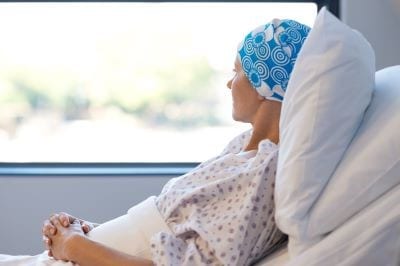 They are supposed to suppress the growth of the cancer cells or, at best, kill them. However, the drug cannot distinguish between healthy and tumour cells. Since it interferes with the process of cell division, it primarily harms cells that divide frequently. This applies to tumour cells, but also to epithelial and bone cells. They are located, for example, at the hair root or in the mucous membranes. This is why chemotherapy often leads to hair loss, nausea and digestive problems. The components of the blood are produced in the bone cells: Platelets, erythrocytes and leukocytes. Chemotherapy lowers their production, leading to exhaustion from anemia. Since leukocytes are important cells in the body’s defense system, the immune system is also weakened after chemo.
They are supposed to suppress the growth of the cancer cells or, at best, kill them. However, the drug cannot distinguish between healthy and tumour cells. Since it interferes with the process of cell division, it primarily harms cells that divide frequently. This applies to tumour cells, but also to epithelial and bone cells. They are located, for example, at the hair root or in the mucous membranes. This is why chemotherapy often leads to hair loss, nausea and digestive problems. The components of the blood are produced in the bone cells: Platelets, erythrocytes and leukocytes. Chemotherapy lowers their production, leading to exhaustion from anemia. Since leukocytes are important cells in the body’s defense system, the immune system is also weakened after chemo.
Radiation
Another conventional medical treatment method to cure cancer is radiation. 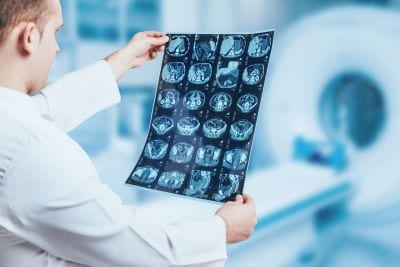 Various types of radiation can be used, such as radioactive, X-ray, electron, neutron, proton, and heavy ion beams. These are all high-energy or ionizing rays. They release electrons from atoms or molecules, which are then supposed to destroy the genes of the tumour cell. In addition, the radiation releases free radicals from the hydrogen in the cell. These in turn destroy the tumour DNA, but also attack enzymes, disrupting the functional processes in the cancer cell. The aim is to stop the proliferation of the cells and, at best, to induce cell death, i.e. apoptosis. In general, tumour tissue is more sensitive to radiation than healthy body tissue. Nevertheless, side effects are not absent here either. Immediate reactions can include reddening of the mucous membranes, nausea, diarrhoea and bladder problems. Long-term damage such as vasoconstriction, scarring in the tissue, bone and tooth damage often only become apparent months or years later.
Various types of radiation can be used, such as radioactive, X-ray, electron, neutron, proton, and heavy ion beams. These are all high-energy or ionizing rays. They release electrons from atoms or molecules, which are then supposed to destroy the genes of the tumour cell. In addition, the radiation releases free radicals from the hydrogen in the cell. These in turn destroy the tumour DNA, but also attack enzymes, disrupting the functional processes in the cancer cell. The aim is to stop the proliferation of the cells and, at best, to induce cell death, i.e. apoptosis. In general, tumour tissue is more sensitive to radiation than healthy body tissue. Nevertheless, side effects are not absent here either. Immediate reactions can include reddening of the mucous membranes, nausea, diarrhoea and bladder problems. Long-term damage such as vasoconstriction, scarring in the tissue, bone and tooth damage often only become apparent months or years later.
Support through medicinal mushrooms
However, conventional medicine can and should always be supported with further pillars. In Asia, “the best of two worlds” – i.e. conventional medicine and naturopathy – is always combined individually for the benefit of the patient. In this context, medicinal mushrooms play a very important role in complementary medicine for cancer. We will now explain their areas of application and mechanisms in more detail.
Complementary cancer therapy
Many patients opt for a combination of classical treatment, alternative medicine and healthy nutrition for cancer. 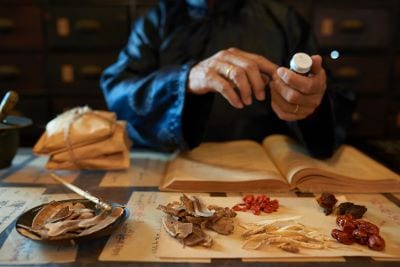 There are definitely synergies here, as complementary treatment methods can also alleviate the side effects of chemo and radiation. All in all, they can add a lot more quality to life with cancer.
There are definitely synergies here, as complementary treatment methods can also alleviate the side effects of chemo and radiation. All in all, they can add a lot more quality to life with cancer.
It is also important that patients feel comfortable with the chosen form of treatment. This usually also means that there is a consensus between the doctor and the patient on exactly what the course of action should be. Unfortunately, complementary treatment methods are not yet as widely recognized in Europe as they are in China, for example. However, many physicians are now exploring combinations and are increasingly realizing the potential of complementary medicine for cancer
Which medicinal mushrooms can support cancer treatment?
In the spectrum of complementary treatment methods, vital mushrooms are a remarkable option. Many of them have been used for healing purposes for thousands of years. In Traditional Chinese Medicine (TCM), their gentle but lasting effect is highly valued. In addition, TCM also attributes a very decisive role to healthy nutrition in cancer.
If medicinal mushrooms are to be used for cancer, a careful selection must be made. It is best to consult an expert to find out which medicinal mushrooms help best with your specific tumour, stage of disease and symptoms. It is conceivable to use the medicinal mushrooms listed below for cancer. What all these mushrooms have in common is that they help the body detoxify. This is always a help in cancer and its treatment, as the organism gets rid of unnecessary burdens. Furthermore, vital mushrooms are rich in polysaccharides, which belong to the dietary fibres. They stimulate the immune system and act against cancer cells in many different ways. In addition, there are antioxidants, which provide valuable services in the prevention and treatment of cancer as well as in the reduction of side effects of conventional medical measures.
Below you will learn how exactly each mushroom helps you to fight cancer.
ABM (Agaricus blazei murill) – “almond mushroom” or “mushroom of life”
The ABM is an edible mushroom and belongs to the genus of button mushrooms. These common mushrooms are always part of a complete cancer diet. But the ABM still has a few very special features that distinguish it from related species: ABM is rich in the long-chain polysaccharides called “beta-D-glucans.” These have a regulating effect on the immune system. This means that they curb excessive immune reactions, as they occur in autoimmune diseases. On the other hand, they activate the cells of the immune system if it happens to be weak. An active immune system is enormously important in order to counteract or to prevent cancer naturally. This is because our immune cells are basically capable of fighting degenerated cells.
Thus, the ABM also plays a central role in the accompaniment of conventional cancer therapy. It supports the bone marrow in its regeneration after radiation or chemotherapy. The faster sufficient erythrocytes are produced again, the sooner states of exhaustion subside. The rapid formation of new leukocytes also gets the immune system going again after chemo.
ABM has been shown to have an inhibitory effect on growth in the following cancers: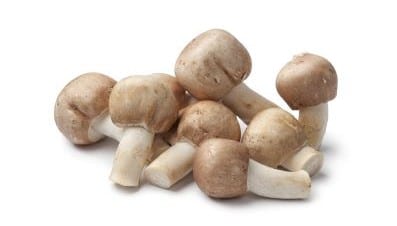
– Lung cancer
– Colon cancer
– Pancreatic cancer
– Prostate cancer
– Liver cancer
– Brain tumours
In some cases, a decrease in tumour tissue was even observed when ABM was administered. It thus seems to support mechanisms that lead to apoptosis of cancer cells.
Furthermore, the ABM makes life easier for those affected by cancer. When taken regularly, an improvement in the general condition could be observed. It protects the liver, which is strongly affected by drugs and other treatments. In the case of leukaemia or lymphoma, it reduces possible swelling of the spleen.
In terms of prevention, the ABM is also a good choice. Comparing all medicinal mushrooms used for cancer, it contains the most antioxidant agents such as superoxide dismutase, catalase and tyrosinase and also activates the production of antioxidant enzymes. These enzymes defuse free radicals in the body’s cells that could otherwise damage DNA. Presumably, this is also the reason why the rural population in the homeland of this mushroom – Brazil – hardly ever developed cancer.
Polyporus
Polyporus is an edible and vital mushroom native to Asia. In addition to valuable polysaccharides, it is rich in active substances that support the lymphatic system in its detoxification. This characteristic comes into play especially when lymph nodes have already been removed in the course of cancer treatment. The stimulating effect of Polyporus reduces the associated risk of lymphatic congestion.
For the same reason, this vital mushroom also supports the immune system after chemo. The lymphatic system is intensively involved in removing toxins from the body during chemotherapy. By promoting the elimination via the lymph, Polyporus effectively prevents symptoms of poisoning.
In lung and liver cancer, the intake of Polyporus showed a slowed down tumour growth.
Coriolus versicolor
This medicinal mushroom has long been used in complementary medicine for cancer. Ötzi already had a close relative of Coriolus versicolor in his first-aid kit 5200 years ago.
With the polysaccharides PSP and PSK, it promotes 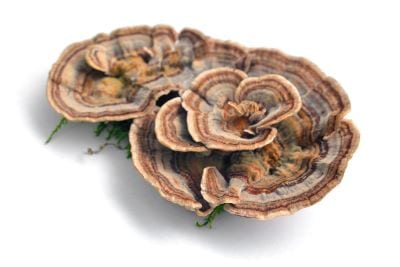 the immune defense. In particular, it activates the TH1 immune response, helps the body fight viruses as well as tumour cells. This is presumably the reason why with some female patients an existing affection with the human papillomavirus (HPV) could not be detected anymore after one year of intake of the Coriolus. The HPV attacks the cervix and can lead to tumour growth there. In the course of the administration of Coriolus versicolor, even existing lesions at the cervix decreased.
the immune defense. In particular, it activates the TH1 immune response, helps the body fight viruses as well as tumour cells. This is presumably the reason why with some female patients an existing affection with the human papillomavirus (HPV) could not be detected anymore after one year of intake of the Coriolus. The HPV attacks the cervix and can lead to tumour growth there. In the course of the administration of Coriolus versicolor, even existing lesions at the cervix decreased.
Furthermore, it seems to cure hormone-dependent cancer naturally under certain circumstances. Here we are talking about breast or prostate cancer, for example. In addition, Coriolus versicolor stimulates apoptosis in various types of tumours. Furthermore, it inhibits tumour growth by hindering the formation of new vessels to supply the tumour.
Thanks to its antioxidant polysaccharides and the ability to activate the body’s own enzymes with antioxidant activity, Coriolus versicolor facilitates living with cancer and its conventional medical treatment. The strong antioxidant effect seems to reduce the damage of radiation to healthy tissues as well as to mucous membranes. Similarly, the cells of the bone marrow are protected from radiation damage, which is why haematopoiesis is less impaired after radiotherapy.
Cordyceps
Cordyceps has some valuable ingredients that can be useful against cancer. With regard to cordycepin, it has been proven in the laboratory that it kills cancer cells. This applies to leukaemia cells as well as breast and prostate cancer cells. So far, however, this effect has not been confirmed outside the test tube. However, it is known with certainty that cordyceps supports the immune system in the fight against tumour cells by regulating the activity of white blood cells, as well as natural killer cells and macrophages.
With regard to prevention and therapy support, the antioxidant effect is to be emphasized. It stimulates the body’s own superoxide dismutase and glutathione peroxidase. Cordyceps militaris also contains the substance ergosterol. This is an antioxidant that has a strong anti-tumour effect in the organism.
If the cancer patient feels weak and its immune system works poorly after chemo, Cordyceps has a strengthening and restorative effect. It quickly brings forward the regeneration after strong continuous stress.
Maitake (Grifola frondosa)
Maitake is both a tasty enrichment of the diet and a medicinal and vital mushroom. It is an excellent, albeit rare, edible mushroom.
After the ABM, the Maitake 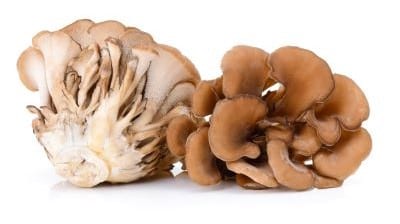 the highest concentration of polysaccharides. The positive effect on the immune system comes primarily from the beta-D-glucans. They stimulate the scavenger cells, which can recognize and destroy tumour cells. The more scavenger cells are active in the body, the lower the risk that a cancer cell remains alive.
the highest concentration of polysaccharides. The positive effect on the immune system comes primarily from the beta-D-glucans. They stimulate the scavenger cells, which can recognize and destroy tumour cells. The more scavenger cells are active in the body, the lower the risk that a cancer cell remains alive.
In alternative medicine against cancer, Maitake has proven particularly effective in the prevention of bone metastases. It is rich in the antioxidant ergosterol, a precursor of vitamin D2. This substance promotes calcium absorption into the bones, making them more resistant. In practice, the inhibitory effect on the formation of metastases has been observed in many different types of cancer.
Especially with brain tumours Maitake also shows a growth-inhibiting effect. In prostate cancer, even the apoptosis of tumour cells was observed when taking Maitake. Thus, the Maitake has a great potential to support a cancer therapy.
Reishi (Ganoderma Lucidum)
The Reishi is one of the longest-known vital mushrooms and has well-proven itself for over 4000 years in Far Eastern medicine. It is a popular remedy when it comes to supporting cancer patients naturally. Among other things, it inhibits the growth of tumour cells in breast, prostate, ovarian, lung and liver cancer.
In prevention, the antioxidant properties of the Reishi show to be extremely efficient. By activating superoxide dismutase, glutathione S-transferase and laccase, it reduces the risk of free radicals damaging the genes in the cells. In addition, antioxidants have an anti-inflammatory effect. Since inflammation is a risk factor for the degeneration of cells, the Reishi also prevents tumour formation at this point.
Accompanying chemotherapy, experts appreciate its beneficial effect on the detoxification processes. Thus, it effectively alleviates unpleasant side effects. In addition, it has the ability to reduce pain and stimulate the appetite. It thus makes an important contribution to improving the quality of life of cancer patients during chemotherapy.
Selection and dosage of medicinal mushrooms
Although many of the vital mushrooms are also tasty edible mushrooms, it is not enough to add regular mushroom dishes to your diet in order to fight cancer. You can only achieve a medicinal effect by taking mushroom powder. As best form of storing the powder capsules have proven themselves: Thus, the mushroom powder is protected from adverse environmental influences and the valuable ingredients are safely preserved.
Also make sure that your source of supply is a competent manufacturer with organic cultivation. 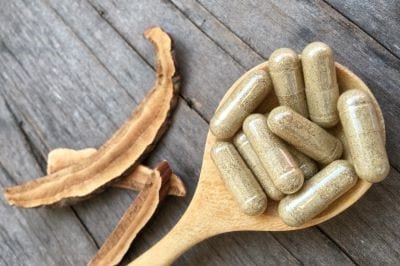 Since mushrooms are predestined to absorb toxins from their environment, medicinal mushrooms in particular must not come into contact with any harmful substances during cultivation. Furthermore, the drying of mushrooms requires a great deal of sensitivity. At temperatures above 40° Celsius, many valuable ingredients are destroyed. Prefer manufacturers from Germany as here the cultivation and production methods are the most transparent.
Since mushrooms are predestined to absorb toxins from their environment, medicinal mushrooms in particular must not come into contact with any harmful substances during cultivation. Furthermore, the drying of mushrooms requires a great deal of sensitivity. At temperatures above 40° Celsius, many valuable ingredients are destroyed. Prefer manufacturers from Germany as here the cultivation and production methods are the most transparent.
To find out which medicinal mushrooms are recommended in your individual situation, you should consult with a specialist from the MykoTroph Institute. The dosage is an important issue, especially in the beginning. If you take too much mushroom powder at the beginning, this can put additional strain on your body due to the strong detoxification. Serious side effects in the actual sense are not known with medicinal mushrooms. Also, with regard to interactions with conventional medicines, there have been no negative experiences so far.
However, besides the type of cancer, the stage, the treatment and the general physical condition, there are many variables to consider when choosing vital mushrooms. Only if the vital mushrooms are exactly matched to you, they can contribute to curing the cancer. Please talk to a mycotherapist!






